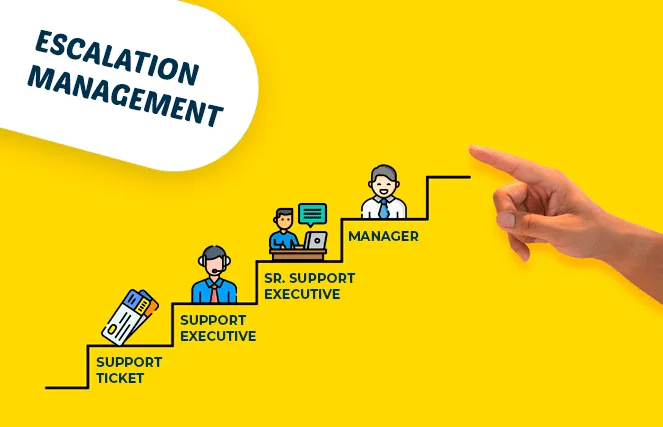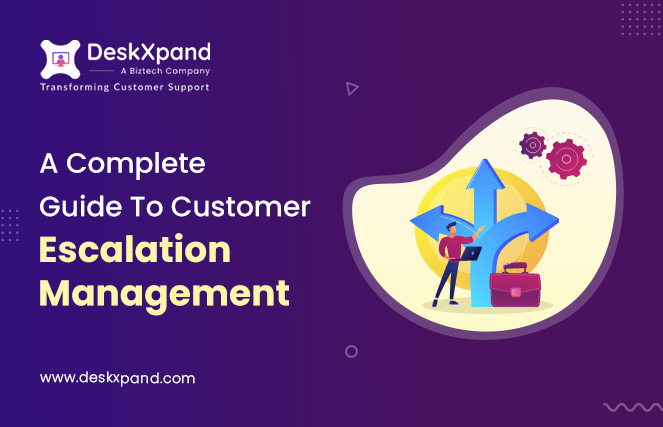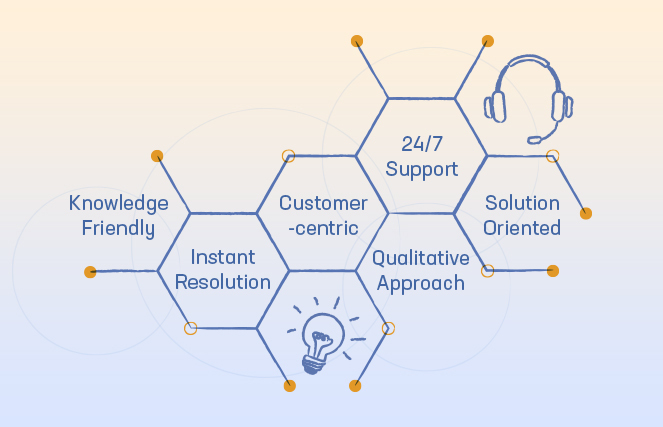Introduction
Managers are on a constant lookout to try to minimize conflicts, especially before they escalate into something serious or extreme that the customer is agitated or frustrated. However, conflict is an inevitable truth of nature. And sometimes, it is even a necessary byproduct to find unique feedback and perspectives and use it to improve your brand.

Divergent positions addressed properly can stimulate innovation and learning in ways like minds can’t even imagine.
Mike Myatt

However, mediation at times of conflict is necessary. Brands should seek ways to prevent lasting conflicts and the productivity-dampening drama surrounding them. On the other hand, they should not run after not experiencing any conflicts anymore. Issue escalation demands more involvement from your customer support executives than anyone else.
Agents don’t want to come across as not trained to handle difficult situations. They do not want to seem like they lack the awareness to know when to approach their manager. So, finding that balance and knowing when to escalate issues and when to not is essential. This article is all about customer escalation management and handling escalations in day-to-day customer support. We’ll talk about:
What is Customer Escalation Management?

When it comes to customer service, the term customer escalation refers to the action where the issue and the details of a customer are sent further in the hierarchy to a more experienced agent. The query of customer escalation occurs when the agent dealing with the issue originally finds that they lack the required authorization or knowledge to resolve/handle the query. More or less, they’re not sure of being able to resolve it to the customer’s satisfaction.
A customer service escalation process can also take place if a customer is unhappy with the provided resolution and requests the matter to be dealt with by a senior manager or supervisor.
Now, when I say escalation, I do not mean that it is always a bad thing. Sometimes, it is better that certain queries be solved by senior authorities to maintain customer delight. For example, suppose an agent is relatively new and does not have the required experience to handle a certain issue. In that case, it is better that they escalate it rather than provide immature results. Many times, support executives lack the authorization to carry out a successful resolution. For example, certain things and queries can only be carried out by finance departments, or say refund and return department. It is better that the queries pertaining to these areas reach their required experts.
Minimizing escalations is a good idea. Sometimes, too many customer escalations can lead to an experience that leaves a customer with a negative feeling overall. Hence, you must have a plan in place to reduce the number of escalations within your team and ensure that all team members are well aware of your customer ticket escalation processes. Let’s look at some common reasons for escalations.
Types of Escalation
In order to successfully handle customer queries, it is important to distinguish between different types of customer escalation. Let’s have a quick and brief look at two types of escalation in customer support:
1. Functional Escalation
Functional escalation generally happens due to an agent’s inability to resolve an issue in the given time. It happens when agents are not able to close tickets on time. In such cases, a little help or time from the higher management could help the agent figure out and resolve the issues.
2. Hierarchical Escalation
Functional escalation generally happens due to an agent’s inability to resolve an issue by themselves. Certain situations also require the involvement of more knowledgeable support executives. This could be tier 2, 3, or even 4. Sometimes, hierarchical escalation also means that the case needs attention from a manager.
Common Reasons for Customer Escalation
Here are the most common reasons for customers seeking escalation:
1. Miscommunication
It refers to the miscommunication between the customer and the support executives. There can be instances where a customer demands escalation that was completely the agent’s fault. They can be rude and inattentive.
2. Lack of Expertise
Another situation can be that your agent does not have the said training level or required knowledge to tackle the questions. They’re simply not qualified enough to resolve the issue, and customer escalation can be a reasonable solution.
3. Delays
It is frustrating for a customer when they are promised a solution within a certain time frame only to find out that their resolution has been delayed. All agents must be able to manage the customer’s expectations. However, they also should not promise a resolution that may not be deliverable. Remember that the agent’s goal is not only to resolve customers’ tickets on time but to provide the right kind of resolution.
4. Breach in the SLA
The service level agreements contain a set of rules that are defined for customer service agents to follow while resolving customer issues. This includes all the reasons that require a customer ticket escalation process. This can vary greatly and depends on the type of product, and the most common reason is that agents are unable to answer the request in time.
Find out how DeskXpand’s interlinked interface can help you achieve 100% SLA adherence
Let DeskXpand be your customer service growth partner to take your customer service one step forward.
Key Components of Escalation Management
Identification
The customer service escalation process begins with the identification of an issue. This can happen through customer feedback, internal monitoring systems, or frontline staff reporting. Once identified, the issue is triaged to assess its severity and potential impact on the organization.
Escalation Levels
Organizations typically define several escalation levels, each with increasing authority and expertise. These levels may include frontline support, supervisors, managers, subject matter experts, and executive leadership. The choice of escalation path depends on the nature and urgency of the issue.
Documentation
Throughout the ticket escalation process, it is crucial to maintain comprehensive documentation. This includes detailed descriptions of the issue, actions taken at each level, and communication logs. This documentation helps in tracking progress, analyzing trends, and ensuring accountability.
Communication
Effective communication is vital in escalation management. Stakeholders need to be informed promptly and accurately about the issue’s status, potential solutions, and the roles they are expected to play. Clear lines of communication prevent misunderstandings and delays.
Resolution and Feedback
The ultimate goal of escalation management is to resolve the issue satisfactorily. Once a resolution is achieved, it is essential to gather feedback from all parties involved to identify areas for improvement and prevent similar issues in the future.
Significance of escalation management
Quick Issue Resolution
By involving the right people at the right time, escalation management accelerates the resolution of complex problems, minimizing downtime and customer dissatisfaction.
Enhanced Decision-Making
It allows organizations to make informed decisions by tapping into the expertise and experience of various stakeholders, ultimately leading to more effective solutions.
Improved Accountability
Escalation management promotes accountability at all levels, as each stakeholder is responsible for their part in the customer service escalation process.
Customer Satisfaction
Timely issue resolution and transparent communication contribute to improved customer satisfaction, loyalty, and trust.
Escalation Management: Best Practices
No matter how efficient your support is, you cannot please everyone all the time. There’ll be instances when your customers will become stressed, frustrated, or demand to speak directly with the manager. For this reason, it is critical that your customer support employees be trained on proper escalation management procedures. You must have an escalation management workflow in place that takes customer service agents through the actions to take. Here are some best practices while designing a ticket escalation process for your business.
1. Understand a Customer’s Value to Your Business
While managing escalations, consider how valuable a particular customer is to your business. If the escalation is problematic and the customer is seeking compensation, review their purchasing history. Before you extend a compensation offer, fetch their account history and think about how long they have been your customer and how much money they have spent on your brand.
High-value customers are more valuable to retain. So, give them more generous compensation offers and still make sure all compensation offers are in your company’s best interest. Is there a refund possible with the said order? Then, refund the customer. Nothing will tarnish your brand’s image faster than nickel-and-diming a customer for short-term revenue. Moreover, it will end your relationship with a customer, and fast.
2. Design an Escalation Matrix
Establish a structure by addressing the way you would want to manage escalations at different levels. Let’s say a customer has not received a response even after the first escalation, you need to route it again to a more competent executive.
Similarly, you can set up a third-level escalation if the ticket is not resolved successfully. You need to clearly define this entire customer service escalation process, and the right people should be assigned ownership of the problem.
If an escalation occurs, the escalation email can be sent to the executive who assigns tickets. It then goes to the reporting manager and finally to all the other regional leads to ensure quick action. You can create a maximum of four levels of escalations, depending on the priority of a ticket.
3. Route Customers to the Right Person from the Beginning
Sometimes, companies are afraid to give customer escalation response teams leeway to close escalations. But then the complaint rises even more, and it potentially wastes the time of management. Instead, try to resolve things at the initial stages only.
You can empower your team to analyze escalations and make reasonable adjustments and offers. Make sure you route the escalations to the appropriate members from the beginning. This will save you a lot of time and will also save customers’ time. Your escalation management software can provide tools that help you easily route traffic.
4. Train Your Agents
Customers are already agitated and angry when they escalate an issue. They expect a certain level of empathy from the support executives who are handling their concerns. At this point, support executives should communicate with absolute clarity and give realistic resolution ETAs.
Lapses in communication will only worsen the situation and cause further delay and frustration. As a support manager, you need to closely monitor how well your team has dealt with escalations in the past. You need to identify potential loopholes and areas of improvement, and based on these insights, you can take a call.
5. Preventive Measures Over Defensive Attitude
Your team needs to drop the defensive attitude and adopt a preventive approach. Being defensive is a natural response when an angry customer yells at you. But, it is important that your support executives know how to avoid such a reaction, and they should know how to always remain calm. They need to take the ‘heat’ of the whole situation down. It is always easier to prevent escalations rather than deal with the after-effects of it.
Make sure that your support team is trained to answer most questions and that they’re well-equipped to resolve any kind of ticket. You must also pay attention to your team’s proactive attitude. In case you’re unable to achieve conflict resolution, you need to make sure that you are not leaving your customers on hold for a longer time. And that too without an explanation. Speak openly about it and provide your customers with full visibility.
6. Do a Root Cause Analysis for Every Escalation
It is important to understand the reasons behind every escalation and take actionable measures to prevent it from occurring again. Consider an escalation where the support executive is not able to respond to customers on time because of the work overload. You could have avoided this escalation by ensuring the workload was distributed optimally between all the agents.
Consider another scenario, say a support agent was dependent on another team for a successful resolution of an issue. And they did not hear from them within the given time. In this case, the ownership of escalation should lie with the other team, who in turn should take the onus to keep the customer informed.
Invest in a Helpdesk for Effective Escalation Management
If you already have a specific ticket escalation process in place, you can automate this process using the advanced workflow features. You can also automatically route issues to specific queues based on various parameters and filters. With your escalation management software connected to your customer conversations, you can route more customers for phone communication.
You can reduce hold time by using the “call customers back” functionality for your support executives. This eliminates some of the friction that can lead to escalation management situations. Besides this, every helpdesk ticketing system should have dynamic timers to let you maintain the ticket timeline. It must also have service agreements and escalation rules that can be set up and modified based on their real-world performance.
You can base your SLAs and apply them to:
- Due dates
- Response time
- Routing workflows
- Resolution time
- Ticket closing limit
You can enable hierarchical escalations automatically and enforce issue prioritization. It’ll help reduce the overall delay and help keep the customer involved in every stage of their ticket lifecycle.
A Brief Overview of DeskXpand
Here are some feature highlights particularly catering to escalation management of our robust, next-gen customer support helpdesk software:
- DeskXpand uses the round-robin method for ticket assignment, empowering support teams to maintain the priorities as per the SLA.
- It can automatically capture and log all incoming tickets and auto-assign each ticket to a specific agent or team based on their skill.
- It lets you apply due dates, response time, routing workflows, and so on, automatically based on your service level agreements (SLAs).
- You can enable automatic hierarchical escalations, enforce issue prioritization, and reduce the overall delay.
- You can specify standardized rules for sending timely updates to your customers about the status of their tickets.
- Workflow automation can significantly improve response time by redirecting the tickets to relevant agents, departments, or support teams.
- Admin can manage automated workflows, tickets, and so on across all the channels through a unified dashboard.
- You can manage the spike in the number of issues on a particular channel by automatically rerouting it to the right agents or team.
- Make the inquiry progress cycle visible to everyone involved and track the progress of individual assignments across various channels.
The Bottomline
Even those who manage conflict well have conflicts and require the attention of a director from time to time. Besides, corresponding through texts, emails, chats, or social media makes it even more difficult as you cannot convey emotions through these mediums. It hence becomes extremely important to let your customers know that you care about them. You can do this by framing excellent escalation management policies. And only the right tool can help you build one. Check out DeskXpand for more.
Start Your Free Trial










